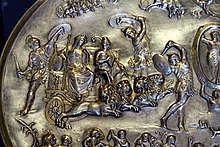Parabiago Plate
(Redirected from
Parabiago plate
)

The Parabiago plate, also known as the Parabiago patera,
The plate is difficult to date. Earlier scholars tended to date it to the 2nd century CE, because of its classicizing style, but stylistic characteristics also permit a later date. Technical analyses, however, support a provenance in the 4th–5th centuries, even though it bears little stylistic resemblance to other silver pieces from that period.[1]
Description
The plate weighs 3555 g and measures 390 mm in diameter. It has a foot-ring of 26 mm in height. The surface is worked with figures in high relief.[1]
- Center left: Corybantes.
- Center right: Rising from the ground is a nude youth who holds up a
- Far right center: A snake twines around an obelisk or gnomon.[6]
- Upper left: The Sun rising in his chariot, preceded by the winged, torch-bearing morning star, Phosphorus.
- Upper right: The Moon setting in her chariot (biga), preceded by the evening star, Hesperus, also winged and carrying a torch.
- Lower center: Four .
- Lower left: Two river nymphs.
- Lower right: eroteswho point toward Cybele. Above the head of Tellus is a small grasshopper and a lizard.
Footnotes
References
- ^ a b c Ruth E. Leader-Newby (2004) Silver and Society in Late Antiquity: Functions and Meanings of Silver Plate in the Fourth to Seventh Centuries, Ashgate, p 146
- ^ Giulia Sfameni Gasparro (1985) Soteriology and Mystic Aspects in the Cult of Cybele and Attis, Brill, p 99
- ^ John Ferguson (1970, 1985) The Religions of the Roman Empire, Cornell University Press, p 26
- ^ Arthur Bernard Cook (1940) edition, (2010) reprinting, Zeus, Cambridge University Press, vol 3, plt 2, pp 1127–1128
- ^ Danuta Shanzer (1986) A Philosophical and Literary Commentary on Martianus Capella's De Nuptiis Philologiae et Mercuii, Book 1, University of California Press, pp 159–160
- ^ Jaime Alvar Ezquerra (2008) Romanising Oriental Gods: Myth, Salvation, and Ethics in the Cults of Cybele, Brill, p 140
Wikimedia Commons has media related to Parabiago patera.
